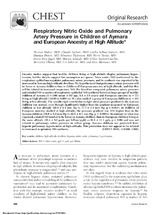Respiratory nitric oxide and pulmonary artery pressure in children of aymara and european ancestry at high altitude*
Fecha
2008-11-07Autor
Stuber, Thomas
Sartori, Claudio
Salinas Salmón, Carlos E
Hutter, Damian
Thalmann, Sébastien
Turini, Pierre
Jayet, Pierre-Yves
Schwab, Marcos
Sartori-Cucchia, Céline
Villena, Mercedes
Scherrer, Urs
Allemann, Yves
Metadatos
Mostrar el registro completo del ítemResumen
Invasive studies suggest that healthy children living at high altitude display pulmonary hypertension, but the data to support this assumption are sparse. Nitric oxide (NO) synthesized by the
respiratory epithelium regulates pulmonary artery pressure, and its synthesis was reported to be
increased in Aymara high-altitude dwellers. We hypothesized that pulmonary artery pressure will
be lower in Aymara children than in children of European ancestry at high altitude, and that this
will be related to increased respiratory NO. We therefore compared pulmonary artery pressure
and exhaled NO (a marker of respiratory epithelial NO synthesis) between large groups of healthy
children of Aymara (n 200; mean SD age, 9.5 3.6 years) and European ancestry (n 77)
living at high altitude (3,600 to 4,000 m). We also studied a group of European children (n 29)
living at low altitude. The systolic right ventricular to right atrial pressure gradient in the Aymara
children was normal, even though significantly higher than the gradient measured in European
children at low altitude (22.5 6.1 mm Hg vs 17.7 3.1 mm Hg, p < 0.001). In children of
European ancestry studied at high altitude, the pressure gradient was 33% higher than in the
Aymara children (30.0 5.3 mm Hg vs 22.5 6.1 mm Hg, p < 0.0001). In contrast to what was
expected, exhaled NO tended to be lower in Aymara children than in European children living at
the same altitude (12.4 8.8 parts per billion [ppb] vs 16.1 11.1 ppb, p 0.06) and was not
related to pulmonary artery pressure in either group. Aymara children are protected from
hypoxic pulmonary hypertension at high altitude. This protection does not appear to be related
to increased respiratory NO synthesis.

